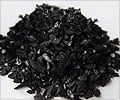Researchers from the University of Michigan have discovered how to measure the absorption of multi-walled carbon nanoparticles into worms and cancer cells. Carbon nanotubes were discovered in 1991, and have a great value in several areas, including pharmacology and for hydrogen storage in fuel cells. But despite their promise, a big problem was that it's not known how multi-walled carbon nanotubes will impact the living environment. This discovery can now help the scientists in understanding how the effect the particle will have on living environment.
The scientific communities were always worried about the result and the extent to which they could get into the human cells. They were unable to do a quantitative research on this because no method to measure them has existed until now. They could always detect them but had no way of knowing how much was there.U-M chemical engineering professor Walter J. Weber Jr. leading the team tagged multi-walled carbon nanotubes with the carbon-14 radioactive isotope, which enabled the nanotubes to be tracked and quantified, as they were absorbed into living cells. Researchers used cancer cells called HeLa cells, and also measured nanotube uptake in an earthworm and an aquatic type of worm.
The findings were presented Sunday at the 231st American Chemical Society National Meeting in Atlanta. Co-authors of the presentation are graduate student Elijah Petersen and postdoctoral research assistant Qingguo Huang.
Petersen said that it's important to understand if and how the multi-walled carbon nanotubes accumulate in living cells, because before the materials can become widely used in society, scientists must understand if they'll pass through the food webs and possibly threaten the health of ecosystems and lead to uptake by humans. This has opened a virtually limitless potential for facilitating important future investigations of the behaviors of carbon nanotubes in environmental and biomedical applications he said.











